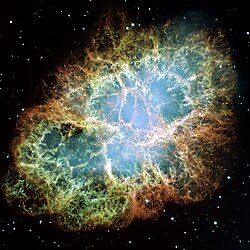Messier Index/M1
| Crab Nebula | |
|---|---|
 M1, the Crab Nebula. Courtesy of NASA/ESA | |
| Observation data: J2000.0 epoch | |
| Type | Supernova Remnant |
| Right ascension | 05h 34m 31.97s[1] |
| Declination | +22° 00′ 52.1″[1] |
| Distance | 6.5 ± 1.6 kly (2.0 ± 0.5 kpc)[2] |
| Apparent magnitude (V) | +8.4 |
| Apparent dimensions (V) | 420″ × 290″[3]a |
| Constellation | Taurus |
| Physical characteristics | |
| Radius | 5.5 ly (1.7 pc) [4] |
| Absolute magnitude (V) | -3.1 ± 0.5b |
| Notable features | Optical pulsar |
| Other designations | M1,[1] NGC 1952[1], Sharpless 244 |
The Crab Nebula (catalogue designations M1, NGC 1952, Taurus A) is a supernova remnant and pulsar wind nebula in the constellation of Taurus. The nebula was first observed by John Bevis in 1731, and corresponds to a bright supernova recorded by Chinese and Arab astronomers in 1054. It is said that it was visible during the day for months, and remained visible at night for several years.
At X-ray and gamma-ray energies above 30 KeV, the Crab is generally the strongest persistent source in the sky, with measured flux extending to above 1012 eV. Located at a distance of about 6,500 light-years (2 kpc) from Earth, the nebula has a diameter of 11 light-years (3.4 pc) and expands at a rate of about 1,500 kilometers per second.
At the center of the nebula lies the Crab Pulsar, a rotating neutron star, which emits pulses of radiation from gamma-rays to radio waves with a spin rate of 30.2 times per second. The nebula was the first astronomical object identified with a historical supernova explosion.
The nebula acts as a source of radiation for studying celestial bodies that occult it. In the 1950s and 1960s, the Sun's corona was mapped from observations of the Crab's radio waves passing through it, and more recently, the thickness of the atmosphere of Saturn's moon Titan was measured as it blocked out X-rays from the nebula.
External links
- Data on the Crab Nebula, on a supernova remnants catalogue managed by David A. Green (University of Cambridge)
- The Crab Nebula at ESA/Hubble
- Messier 1, SEDS Messier pages
- Images of the Crab from the Chandra X-ray Observatory
- Chandra page about the nebula
- Images of the Crab from the Hubble Space Telescope
- Lord Rosse's drawings of M1, the Crab Nebula from SEDS
- NightSkyInfo.com - M1, the Crab Nebula
- M1 The Crab Nebula
- Slooh Video Podcast on M1
- M1 The Crab Pulsar in Crab Nebula / Video
- ↑ a b c d "SIMBAD Astronomical Database". Results for NGC 1952. Retrieved 2006-12-25.
- ↑ Kaplan, D. L.; Chatterjee, S.; Gaensler, B. M.; Anderson, J. (2008), "A Precise Proper Motion for the Crab Pulsar, and the Difficulty of Testing Spin-Kick Alignment for Young Neutron Stars", Accepted for publication in the Astrophysical Journal, 677: 1201, doi:10.1086/529026
- ↑ Invalid
<ref>tag; no text was provided for refs namedTrimble1973 - ↑ Carroll, Bradley W.; Ostlie, Dale A., An Introduction to Modern Astrophysics, Second Edition
